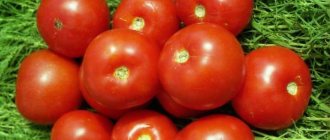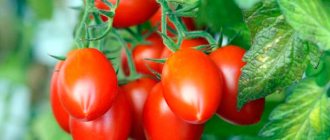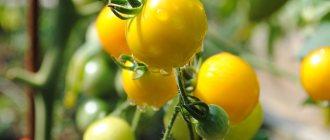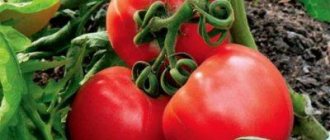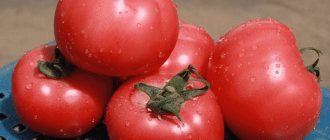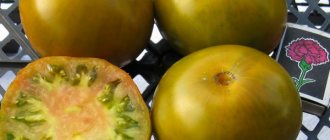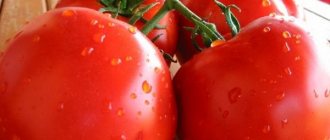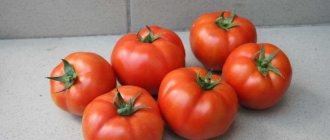Every gardener has classic red tomatoes in his garden. But what is better to choose among such a variety? Agricultural experts advise taking a closer look at the Marissa F1 tomato. The hybrid has many valuable qualities - productivity, early ripeness, unpretentiousness, and the possibility of universal use.
| Height | Landing location | Ripening time | Fruit color | Fruit size | Origin | Fruit shape |
| Tall | Greenhouse, Open ground | Early ripening | Reds | Average | Hybrid | Round |
Description of the variety
Fruit:
- They have a round shape, slightly flattened;
- Those that have not reached varietal ripeness are green in color with a dark green spot near the stalk; as they ripen, they become red;
- With dense, fleshy pulp, red in color, pleasant taste, with a slight sourness;
- The number of seed chambers is from 4 to 6;
- Medium size.
The average weight ranges from 150 to 180 grams.
Bushes:
- Indeterminate type, with average formation of green mass;
- They have a powerful, branched root system;
- It can reach a height of up to 3.5 meters;
- The leaves are medium in size and color varies from green to dark green.
Tomato Maryushka: description and characteristics of the variety, yield with photos
Tomato "Marissa F1": description of the variety
| Variety name | Marissa F1 |
| general description | Early maturing indeterminate hybrid |
| Originator | Russia |
| Ripening period | 100-110 days |
| Form | Round, slightly flattened |
| Color | Red |
| Average weight of tomatoes | 150-180 grams |
| Application | Tomatoes are good fresh and for canning. |
| Productivity of the variety | 20-24 kg per square meter |
| Features of cultivation | Standard agricultural technology |
| Disease resistance | Resistant to most diseases |
Indeterminate tomato from.
The bush grows up to 3.5 meters with a powerful, branched root system. Designed for growing in a greenhouse. Formation into one trunk on a vertical support or trellis with obligatory tying is required. Stepsonning is recommended.
3-4 bushes are planted per square meter. Hybrid of early ripening, medium foliage.
- The shape of the fruits of hybrids is round, slightly flattened.
- Weighing from 150 to 180 grams.
- Dense, fleshy red tomatoes.
- They tolerate transportation well.
- The taste is slightly sour.
- They have from 4 to 6 cameras.
Excellent for canning, preparing various pastes and eating fresh.
Attention: Do not take seeds from hybrids for subsequent planting. They will not repeat the result in the second year. If you like the hybrid, purchase fresh seeds from trusted companies.
Vitaly M., Krasnodar: “I saw a description of the Marissa variety on one of the gardening sites and decided to try to grow it. I planted an experimental bed and was overall pleased. The fruits are small and the yield is average, but due to their good shelf life I was able to send them to relatives in another city. Several days on the road did not affect the taste of the tomatoes. And we ourselves enjoyed preparing salads and other dishes with this variety - everyone liked the pleasant taste and dense pulp.”
Angelina V., Tyumen: “We can only grow tomatoes in greenhouses: summer is too short, and during these few warm days the plant will not have time to bloom and bear fruit. Therefore, I usually choose varieties that are suitable for greenhouse cultivation, including those that are disease resistant. In this regard, the Marissa tomato variety suited me quite well.
Evgenia R., Syktyvkar: “I heard good reviews about the Marissa tomato variety from friends, so I tried to plant it. For myself, I came to the following conclusion: advantages - disease resistance, good shelf life and pleasant taste; disadvantages - additional care in the form of gartering and pruning, demanding temperatures, relatively low yield.
Description and characteristics of the variety
The bush is of a determinate type; it does not grow higher than 80 centimeters in height. At the same time, it is powerful and branched. When grown, it does not require pinching because it is limited in growth. After several clusters of fruit, growth stops. Above the 7th leaf, the first brush with a beautifully shaped cluster is formed. Up to 9 fruits can ripen simultaneously on one branch.
Tomatoes have an average ripening period - 110–112 days pass from seed germination to the first ripe tomato. Bred for cultivation in open ground. If necessary, you can get an excellent harvest in closed areas.
Tomato Marissa F1 is an indeterminate tall hybrid. Characteristics of bushes:
- reach a height of up to 1.8 m;
- shoots are thick, strong;
- moderate branching and bushiness;
- 4-6 tomatoes for 1 bunch.
Ripening dates are early - after 88-95 days from germination.
What are the characteristics of the fruit:
- average weight 150-180 g;
- the pulp is scarlet, moderately juicy, oily;
- ribbing is moderately expressed at the stalk;
- The skin is strong, dense, easy to bite, and does not crack.
The taste is classic - tomato sourness against a background of sweet undertones.
Features of cultivation and storage
Grown through seedlings. Seedlings are transplanted at the age of 55-60 days.
- watering 3 times a week;
- guidance in 3 barrels;
- tying and stepson;
- application of fertilizers.
The Marissa tomato variety is characterized by abundant flowering and ovary formation. It is recommended to thin them out during the flowering period, otherwise there is a risk of getting a large number of small fruits. When the first bunch is formed into 4-5, and the remaining 5-7 fruits, the yield per square meter will be from 20 to 24 kilograms. Collection is best done 3-4 times per decade.
If transportation is required, it is recommended to remove not fully ripe, “brown” tomatoes.
The second version of the tomato of the same name
You can also find another version of the hybrid of the same name on sale. Tomato "Marissa F1". Basically it is similar to its Dutch namesake, but there are some differences:
- Determinate, universal growing method.
- When grown in open ground, the start of fruit ripening increases by 3-5 days.
- The height of the bushes is 1.0-1.2 meters. The bush is quite compact.
- Plant 5-6 plants per square meter.
- Requires tying to a vertical support.
The yield of plants obtained from seeds will be slightly higher due to the larger placement of plants in the same area and will range from 22 to 26 kilograms. The formation of a cluster occurs in 5-6 fruits.
If you decide which hybrid is best for you to grow on your site, then feel free to purchase seeds. With proper care, processing, timely watering and fertilizing, both hybrids will delight you with a good harvest.
Tomatoes: advantages and disadvantages
Tomato hybrid "Marissa" has the following unique properties:
- Early ripening;
- Long fruiting period;
- Immunity to diseases characteristic of tomatoes;
- Ability for long-term storage;
A minor drawback of the hybrid is the need for tying and pinching due to the tallness of the bushes.
- Possibility of transportation over long distances;
- Commercial appearance of the fruit;
- Excellent taste characteristics;
- Good yield.
Experienced gardeners recommend the Marissa F1 tomato: reviews and photos of tomatoes, description of the variety
Every gardener has classic red tomatoes in his garden. But what is better to choose among such a variety? Agricultural experts advise taking a closer look at the Marissa F1 tomato. The hybrid has many valuable qualities - productivity, early ripeness, unpretentiousness, and the possibility of universal use.
| Height | Landing location | Ripening time | Fruit color | Fruit size | Origin | Fruit shape |
| Tall | Greenhouse, Open ground | Early ripening | Reds | Average | Hybrid | Round |
Description and characteristics of the variety
Tomato Marissa F1 is an indeterminate tall hybrid. Characteristics of bushes:
- reach a height of up to 1.8 m;
- shoots are thick, strong;
- moderate branching and bushiness;
- 4-6 tomatoes for 1 bunch.
What are the characteristics of the fruit:
- average weight 150-180 g;
- the pulp is scarlet, moderately juicy, oily;
- ribbing is moderately expressed at the stalk;
- The skin is strong, dense, easy to bite, and does not crack.
Advantages and disadvantages
- productivity;
- commercial qualities;
- excellent taste properties;
- cold resistance;
- drought and heat tolerance;
- disease resistance.
Minuses:
- the need for garter, feeding.
Productivity
From 1 m2 they collect 8-10 kg.
Marissa's tomatoes are versatile for cooking - good fresh, canned, or pickled. They make rich juices and aromatic ketchups.
Features of cultivation and storage
- watering 3 times a week;
- guidance in 3 barrels;
- tying and stepson;
- application of fertilizers.
Planting and care
How to sow and care:
- seeds are sown from the end of February and throughout March;
- until germination, keep the boxes under film;
- additionally illuminated with phytolamps;
- fed with Kemira or Agricol.
Diseases and pests
The hybrid is resistant to a number of diseases:
In the event of an invasion of pests - cutworms, aphids, slugs - they are saved by folk remedies. These are infusions of celandine, soap and saline solutions.
Growing tomatoes
The best way to cultivate a hybrid is from seedlings.
How to prepare seeds?
The planting material does not need to be additionally treated or soaked immediately before sowing.
Sowing seed material
Description:
- Planting material is sown for seedlings in late March-early April;
- For sowing, use warm prepared soil (peat-sand compost), into which the seeds are buried 1 cm. After sowing, water with warm, settled water;
- Next, the containers are covered with film and put in a warm place. After 5-6 days the first shoots will hatch. The film is removed and the seedlings are placed in sunlight, so that direct sunlight does not fall on the seedlings;
- After 14-21 days, they begin picking into separate pots;
- Throughout their growth, seedlings should be provided with good lighting. For this purpose, the containers are periodically rearranged and rotated;
- Within 10-12 days before planting in a permanent place, seedlings should be hardened off, with a gradual decrease in temperature.
To do this, seedlings are placed in greenhouse shelters or containers are placed in the open air, avoiding overcooling of the seedlings.
Rules for planting seedlings
Description:
- As soon as the seedlings reach the age of 60-65 days (in May), they are ready to be transplanted into greenhouse structures; they can be planted in unprotected soil in June, as soon as the spring frosts have ended. At the time of transplantation, seedlings should have 6-7 full leaves and one flower cluster;
- Immediately before planting, the soil is disinfected and fertilizers are applied. To grow tomatoes, use beds after cucumbers, cauliflower, zucchini, dill, carrots, parsley, since they are not susceptible to nightshade diseases;
- It is recommended to use the following planting pattern: 30x50 cm. Accordingly, to avoid crowding, place 3 to 4 tomato bushes per 1 m2.
Growing from seeds
Planting a crop begins with preparing and germinating seeds. This variety is not a hybrid, so seeds can be prepared from fruits from the previous harvest. Or buy it in a specialized store.
You need to start germinating seeds 60-65 days before planting them in a permanent place in open ground or a greenhouse. In mid or late March, depending on the length of the summer season.
Seed preparation
Includes their processing. First you need to select the most viable seeds that will give a good harvest. The selection process takes place in a specially prepared liquid.
Add a pinch of salt to a glass of water, place the seeds and mix thoroughly. Leave for a few minutes. As a result, all empty seeds should float.
Next, they are disinfected. For a quick procedure, prepare a weak solution of manganese. Place the seeds there for 20-30 minutes.
In order to improve germination, create lasting immunity in a young seedling, and increase productivity in an adult plant, prepare the following solution:
- dissolve baking soda;
- add 4 drops of Fitosporin and aloe plant juice;
- Place the seeds in this mixture overnight.
The solution also provides disinfection.
Seeds must be hardened. They are wrapped in damp gauze and placed in the refrigerator for a day.
Sowing seeds
For planting you will need a small container in the form of a wooden box or peat cup.
The composition of the soil should be light and contain organic matter. The land is purchased ready-made or made independently. Preparation begins 2 weeks before use.
To prepare the soil you will need:
- 2 parts of turf land;
- 1 part each: sand, ash, rotted manure and peat.
After this, the soil is disinfected by calcination in the oven and impregnation with a manganese solution. The soil is dried and placed in cellophane. Place in a dark place to restore beneficial microflora.
Sequential steps for planting seeds:
- Fill the container 2/3 with soil;
- put 2-3 seeds in one place;
- maintain a distance of 3 cm between seeds;
- Sprinkle a layer of earth on top;
- moisten the soil with a spray bottle;
- cover with plastic wrap.
Place the containers in a dark place. The ambient temperature should be around +25 C.
Seedling care
After 4-7 days, shoots appear. The container with greens is transferred to a cooler place for hardening. The temperature should not fall below 16 C. A balcony, veranda or other similar room is suitable for this.
The film must be removed gradually to give the seedlings time to get used to the new temperature. Start with 2-3 hours during the day and gradually increase it.
Seedling care includes:
- Lighting. Good growth is ensured by constant natural light for at least 16 hours a day. If there is a deficiency in it, you need to extend daylight hours with the help of artificial lamps.
- Watering. Irrigate the soil under young seedlings with a spray bottle.
- Feeding. 2 weeks after emergence, apply the first fertilizing. To do this, use weakly diluted natural organic matter in the form of manure or bird droppings.
When caring for tender seedlings, try to keep moisture away from the leaves.
Transplanting seedlings
The next step in caring for seedlings is picking. The process of transplanting young shoots into a large container of 200-500 ml. It is carried out on days 8-14, when the plant has two leaves.
The sprout is transplanted into soil with the same composition as for germinating seeds. The seedlings need to be taken along with a lump of earth around the roots. You can use a small spoon for scooping.
Be sure to harden it. This is done 2-3 weeks before transplanting into open ground. You need to take the sprouts out into fresh air every day. Start with 5-10 minutes and gradually increase the time.
Gradually, the seedlings should harden enough to be outdoors for the last few nights and not freeze.
Bush care
In the future, adhere to the following care:
- Water regularly, in small portions. It is optimal to use a drip irrigation system;
- Since during watering the amount of nutritional components is significantly reduced, they must be replenished periodically. The tomato hybrid is fed 3-4 times during the growing season: during soil preparation, then during flowering and during fruiting. The main necessary elements are phosphorus, nitrogen and potassium, as well as trace elements. The ideal option is to use mineral complexes. However, one should not neglect organic fertilizers, which must be added to the soil during its preparation;
- It is also worth remembering about loosening, which is an important procedure. Loosen the soil every two to three weeks. Thanks to loosening, the soil is enriched with oxygen, and moisture stagnation, which is dangerous for tomato crops, is eliminated;
- The bush is formed into one trunk and must be tied to a vertical support or trellis as it grows;
- Another mandatory procedure is stepsoning;
- The hybrid is self-pollinating; the greatest activity is achieved at +25 degrees and 65% humidity level. In greenhouse conditions, the pollination process is optimized using vibration or hormonal drugs.
Tomato Mars F1: hybrid features, photos, reviews
Tomato Marco F1 is a productive hybrid suitable for different types of greenhouses.
In regions with warm climates, seedlings can also be planted in the ground. The fruits ripen beautiful and tasty, they are eaten fresh, canned, and processed into juices, sauces, and purees. Tomato Marco F1 is a productive hybrid suitable for different types of greenhouses
Marco F1 is a first generation hybrid proposed by Belarusian breeders. These tomatoes have appeared on the market recently, but have already found their fans. Plants are ideal for heated year-round greenhouses, film greenhouses and other types of shelters.
This versatility makes the plant suitable for any region. In areas with a warm climate, bushes are planted directly into the ground, covered with film during bad weather or night frosts. Tomatoes tolerate daily temperature fluctuations and can easily tolerate short-term drought.
Bushes of determinate type, low, strong, compact. Suitable for fairly dense planting and do not require wide row spacing. In a greenhouse, the stems may stretch; tying and pinching of the growing point will be required. The branches are not too spreading, the formation of green mass is average. The leaves are small, heavily cut, brightly colored.
Tomatoes are early ripening, the first fruits ripen 95-100 days after emergence. The seedlings are strong, resilient, and not susceptible to typical nightshade diseases.
Early ripening and a shortened growing season protect stems and fruits from late blight. Resistance to cladosporiosis, verticillium and viruses is high.
With proper care, the yield is high; up to 7 kg of selected fruits can be harvested from 1 m² of planting.
The tomatoes are quite large, smooth, and beautiful. The weight of individual specimens reaches 250 g, but most tomatoes weigh from 180 to 200 g. On the lower branches the fruits are more massive.
The shape is round, slightly flattened, with pronounced ribbing at the stalk. During the ripening process, the color changes from pale green to orange-red (the Belle tomato, known among amateur gardeners, has similar shades).
The skin is glossy, moderately dense, perfectly preserving the pulp from cracking.
The tomatoes are juicy but not watery, with few seeds. Fleshy and sugary when cracked, Marco tomatoes are suitable for salads and canning. This versatility is reminiscent of the Belle tomato, but this variety is distinguished by smaller fruits.
This hybrid is a little similar to the popular varieties Irishka, Berberana, Skif, Seven Forty, Snowfall, Gilgal, Magnus. Another well-known analogue is the Strawberry F1 tomato, which has similar flavor notes, but is slightly different in appearance.
Despite the fact that Marco appeared on the market recently, consumers have already formed an opinion about this hybrid. Its main advantages include:
- good yield;
- early amicable maturation;
- versatility of fruits;
- compactness of the bushes, indispensable for small greenhouses;
- possibility of cultivation in closed or open ground;
- resistance to major nightshade diseases;
- immunity to insect pests;
- excellent keeping quality;
- possibility of transportation.
Tomatoes are suitable for preparing salads, side dishes, soups, sauces and purees. You can squeeze beautiful red-orange juice from ripe tomatoes, which you can drink fresh or preserve for the winter. The fruits are recommended for baby food and industrial processing.
The seedlings are strong, resilient, and not susceptible to typical nightshade diseases.
Minor disadvantages of the variety include:
- high demands on lighting, fertilizing and soil composition;
- inability to collect seed material; seeds do not retain the properties of the mother plants.
To avoid disappointment, seeds should be purchased from trusted suppliers.
The seed material is packaged in branded bags, decorated with images of ripe fruits, provided with a detailed description of the variety and the characteristics of its cultivation.
Beginning gardeners can purchase grown seedlings suitable for planting in greenhouses or garden beds. It is worth buying it at fairs that guarantee the authenticity of the product.
A description of the hybrid can be found on specialized forums and in reference books devoted to new products in vegetable growing. However, there is not much information about the Marco F1 yet.
Reviews are left by gardeners who have already tried the new product in their garden beds. They note the ease of caring for the bushes, as well as the fact that the yield strongly depends on the amount of fertilizer applied.
The more nutritious the soil, the more tomatoes you can harvest at the end of the season.
| Ripening period: | 90-95 days |
| Shape, weight of fruits: | flat-round, weighing 60-80 grams |
| Determinacy: | bush height 60 cm |
| Growing regions: | Volga region, Central Russia, Rostov region, Krasnodar region |
| Productivity: | high-yielding, 7-7.6 kg per sq. m. |
Tomato Mars F1 is liked by farmers and gardeners because of the hybrid’s high resistance to infectious diseases, good taste, and attractive appearance of the fruit. This variety of tomatoes is grown for making salads, tomato paste, and canning. The plant is suitable for greenhouses and outdoor cultivation.
The early ripening hybrid Mars matures in 3-3.5 months from the moment of emergence. It has several characteristic features:
- bush height up to 0.6 m;
- fruits are formed starting from the 6th leaf from the root;
- small leaves are painted in dark green tones;
- ripe tomatoes are bright red;
- The flat-round fruit has a good taste;
- tomatoes are not prone to cracking.
READ MORE: Red lady potatoes description and characteristics of the variety, yield with photos
Breeders note the high yield of the hybrid. The variety is cultivated for raw consumption, preservation, and preparation of first and second courses.
Mars F1 tomato fruits are stored for a relatively long time. The vegetable has a thick, dense skin and is suitable for transportation over long distances.
According to its characteristics, the variety is similar to cherry tomatoes. Miniature tomatoes have small leaves, medium-sized bushes, long and abundant fruiting.
Timing of sowing seeds
To grow vegetables in a field or garden bed using seedlings in regions south of the Rostov region, seeds are sown in late February - early March. For the middle zone and northern regions, the deadlines are shifted by two to four weeks.
If the variety is cultivated without preliminary forcing of seedlings, seed material begins to be sown in the ground after the soil warms up to 18 degrees.
In the Rostov region and to the south of this region, it is permissible to plant tomatoes under a film booth at the end of winter. Keep the sprouts covered until warm weather arrives. When it gets hot outside, the film on the sides is opened slightly. For regions where there is frequent hail and the sun is very hot, this method of cultivation allows you to preserve the harvest.
In a greenhouse, self-pollinating hybrid varieties grow well at any time of the year. It is beneficial to sow seeds in closed ground three months before the planned ripening.
The Mars tomato is easy to care for and produces high yields with any growing method. Hybrid varieties are resistant to most types of pests and infectious diseases. The culture calmly tolerates changing weather conditions. Plants do not require abundant watering and frequent feeding.
These green manures accumulate nitrogen in the ground. The remains of such plants are not removed from the garden. In autumn, the soil is plowed together with them. To prevent the beneficial substance from being washed out, you can add charcoal to the soil.
A place for planting tomatoes is chosen in open sun. Areas where there are no drafts are good. In southern gardens, corn is often planted next to the beds of these vegetables. The tall crop shades the tomatoes and prevents them from drying out in the sun.
There are plantings of garlic, parsley, and dill around. Strong-smelling herbs help protect crops from pests.
The Mars tomato variety bears fruit best in light soil rich in organic matter and minerals. It responds positively to fertilization.
Mars F1 prefers loose soils. The beds with tomatoes are cleared of weeds. Bushes are watered in the middle zone once a week, in the southern arid regions - daily (except for rainy days).
Solanaceae do not tolerate swampy soils; their roots begin to rot. Therefore, water the plants when the soil dries out.
To make caring for tomatoes easier, you can use mulching film. It prevents moisture from quickly evaporating from the soil surface and stops the growth of weeds.
In the south of Russia in the Stavropol Territory, Chechnya, Krasnodar Territory, and Rostov Region, black mulch is treated with an aqueous solution of chalk in the summer. In these regions, from May to August, the air temperature is above 30-40 degrees. Under the black film the soil will heat up even more; the white color repels the hot rays of the sun and prevents the roots from overheating.
Manufacturers treat hybrid seeds with compounds that protect crops from infections and insects. Mars tomatoes only get sick if they are not cared for properly. They are highly resistant to fusarium, late blight and tobacco mosaic virus. If the bushes are over-watered, the roots and fruits are affected by rot.
It is recommended to regularly inspect the plant for pests such as spider mites, aphids and slugs.
The Mars tomato has many positive qualities:
- resistant to hot southern climates;
- cold-resistant, tolerates spring temperature changes well;
- bears fruit abundantly;
- gives away the harvest together;
- does not require care;
- rarely suffers from infectious diseases;
- not picky about the composition of the soil.
Caring for crops and mature bushes comes down to loosening, timely watering and weed removal. Fertilizing is applied according to the standard scheme.
Diseases and pests
One of the advantages of the Marissa tomato hybrid is its immunity to most diseases and pests, namely:
- Cladosporiosis;
- Alternaria stem cancer;
- Root rot;
- Tobacco leaf mosaic virus;
- Fusarium and verticillium wilt;
- Tracheomycosis wilt.
If garden pests are a concern, use folk remedies and chemicals (in the form of solutions), which are available in a wide range in specialized stores. The resulting solutions are used to spray leaves.
Productivity
Each plant allows you to harvest from 4 to 4.6 kg of tomatoes, respectively, from 1 m2 of planting the yield reaches from 20 to 24 kg.
Which regions are best to grow in?
Hybrid tomato "Marissa" is recommended to be grown in unprotected soil in areas with warm climatic conditions: southern Russia, Ukraine, Moldova. In more northern regions, greenhouse structures are used for cultivation.
Yield varieties of tomatoes in seeds and in reality:
Features of cultivation
The Marissa tomato variety is characterized by abundant flowering and ovary formation. It is recommended to thin them out during the flowering period, otherwise there is a risk of getting a large number of small fruits. When the first bunch is formed into 4-5, and the remaining 5-7 fruits, the yield per square meter will be from 20 to 24 kilograms. Collection is best done 3-4 times per decade.
The yields of other varieties are presented in the table below:
| Variety name | Productivity |
| Marissa | 20-24 kg per square meter |
| American ribbed | 5.5 per bush |
| De Barao the Giant | 20-22 kg per bush |
| King of the market | 10-12 kg per square meter |
| Kostroma | 4.5-5 kg per bush |
| Summer resident | 4 kg per bush |
| Honey Heart | 8.5 kg per square meter |
| Banana Red | 3 kg per bush |
| Golden Jubilee | 15-20 kg per square meter |
| Diva | 8 kg per bush |
If transportation is required, it is recommended to remove not fully ripe, “brown” tomatoes.
